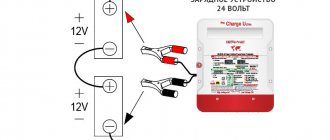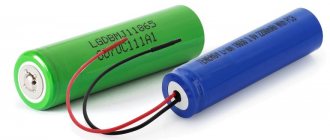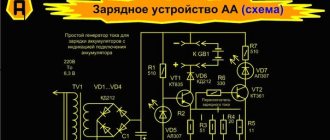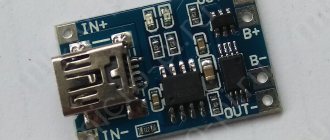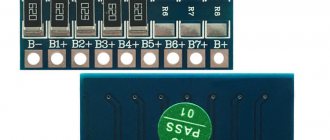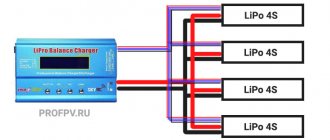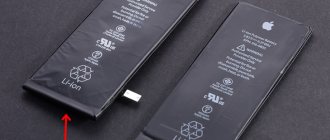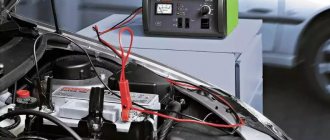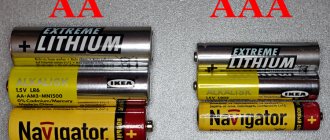general characteristics
Today, many sizes and types of batteries are used. One of the most popular is the 18650 battery. It has a cylindrical shape. Externally, such a battery resembles AA batteries. Only the presented type is slightly larger in size than the usual devices.
During operation, the question always arises about how to charge an 18650 battery. This is a simple procedure. However, you need to treat it with full responsibility. The longevity of the battery depends on proper charging.
Batteries of this type are used today to power laptops, as well as electronic cigarettes. This made the presented standard size popular. Similar batteries are also installed in flashlights and laser pointers. Most often, the devices presented are of the lithium-ion type. This type of battery has proven its efficiency and ease of use.
A little about lithium-ion batteries
These include the following aspects:
- high density of output current and accumulated energy, long-term charge retention;
- no effect of capacity reduction due to regular incomplete charging;
- self-discharge no more than 4-8% per month when stored without recharging, aging no more than 15-20% per year;
- no need for a full discharge to train the energy capacity of the drive;
- light weight, variability of shape and dimensions of the device;
- operating temperature range – from -20°С to +50°С (low temperatures prevent recharging);
- long service life (up to 10 years of operation and more than 1000 discharge cycles).
The disadvantages of lithium batteries are:
- dependence of the service life on the duration of use and storage, and not on the number of discharge cycles;
- risk of failure during overcharging (current flow upon completion of charging);
- low resistance to deep discharge;
- high price;
- explosion hazard due to mechanical damage and excess current, if they lead to heating of the electrolyte and breaking the seal of the housing.
The name of the 18650 battery is due to its shape and dimensions. The battery width is 18 mm and the length is 65 mm. The last number in the marking indicates the cylindrical shape of the battery. The drive circuit is equipped with a controller that prevents overheating during charging.
The battery case can be marked in more detail: for example, INR18650-20R. The first letter distinguishes all lithium-type batteries, the second specifies the type of cathode material (C – cobalt, N – manganese, F – ferrophosphate).
The letter "R" stands for rechargeable. The next 5 digits reflect the dimensions and shape factor of the battery, and the last one is the battery capacity in Ah.
18650 batteries with a protection board can be labeled as 18700 or 18670. The protection board controller helps prevent the battery voltage from exceeding the rated voltage (4.2 V) and falling below 2.5 V.
Peculiarities
When considering how to charge an 18650 battery for a flashlight, electronic cigarette and other devices, it is necessary to describe the principle of its operation. The presented standard size is available in the lithium-ion battery category. It has small dimensions. The height is only 65 mm and the diameter is 18 mm.
Inside the device there are metal electrodes between which lithium ions circulate. This allows the generation of electric current to power equipment. When the charge is low or high, more ions are formed on one of the electrodes. They grow on the material, changing its volume and characteristics.
In order for the battery to work long and fully, it is necessary to prevent the appearance of a deep or too high charge. Otherwise, the device will quickly fail. Depending on the battery ratings, special types of chargers are used.
How to properly charge a 18650 battery without a protection chip?
In the absence of a Li-ion protective chip, it is important to protect batteries from overcharging and strong discharge - do not allow the voltage to drop below 2.9 V. Such power sources must be charged with special chargers that can inform users when the battery is fully recharged.
After such information, the battery must be removed from the charger, otherwise overcharging will occur. If necessary, you can remove the battery earlier, until it is fully charged. It is dangerous to charge unprotected batteries with a charger that does not indicate that the battery is fully charged. When overcharged, batteries without a protective microcircuit overheat and may catch fire.
Battery protection
Today, the types of batteries presented are available complete with a special controller or contain manganese. Previously, batteries were produced without protection. In this case, you needed to know how to charge an 18650 battery correctly for your own safety.
The fact is that a device that did not have special protection could overheat greatly if it was charged incorrectly or for too long. In this case, a short circuit and even a fire or explosion of the battery could occur. Today, the use of such structures has sunk into oblivion.
All lithium-ion batteries are designed to protect against such negative phenomena. Most often, a special controller is used. It monitors the battery capacity level. If necessary, it simply turns off the battery. Some types of structures contain manganese. It significantly influences the chemical reactions inside. Therefore, such batteries do not need a controller.
What is TP4056 charging board and how to use it
We learned how to properly charge lithium-ion batteries. But how to do this? You can use a purchased charger, but if you wish, you can actually assemble a charger for lithium batteries yourself. To do this, it will be enough to buy a ready-made TP4056 module and assemble a simple circuit.
TP4056 1A Lithium Cell Charging Module
The beauty of this solution is that all the fun costs about 30 rubles on Aliexpress. To assemble a finished device based on this module, you need to assemble the following simple circuit.
By default, such a module produces a charging current of 1 A and is suitable for charging batteries with a capacity of 2,000–3,000 mAh. If we need less current, then it is enough to change the value of resistor R3 in accordance with the table:
| R3 rating, kOhm | Charging current, mA |
| 10 | 130 |
| 5 | 250 |
| 4 | 300 |
| 3 | 400 |
| 2 | 580 |
| 1,66 | 690 |
| 1,5 | 780 |
| 1,33 | 900 |
| 1,2 | 1000 |
In principle, with a current of 1 A you can charge batteries with a larger capacity, but it will take more time. But if you still need a current of more than 1 A, then it will be easy to increase it by connecting several modules in parallel. To do this, we simply connect the terminals of the modules of the same name with jumpers.
Healthy. You can do it easier by simply buying a module that provides a charging current of up to 3 A. True, this will cost a little more, but the design will be more compact and easier to assemble.
Charging Features
Many buyers are interested in how to charge a 18650 Li-Ion battery (3.7V). You need to familiarize yourself with the features of such a process. It's quite simple. Modern manufacturers make special devices that control battery charging.
Lithium-ion batteries have virtually no memory effect. This provides a set of rules when charging and operating batteries. The memory effect is a gradual decrease in battery capacity when it is not fully discharged. This property was typical for nickel-cadmium batteries. They had to be completely discharged.
Lithium-ion batteries, on the contrary, do not tolerate deep discharge. They need to be charged to 80% and discharged to 14-20%. In such conditions, the device will serve as long and productively as possible. The presence of special boards in the design simplifies this process. When the capacity level drops to a critical value (most often to 2.4 V), the device disconnects the battery from the consumer.
Useful tips for using 18650 batteries
Lithium-ion batteries are sensitive to deep discharge. It is not recommended to frequently conduct training aimed at restoring capacity. Proper charging helps extend battery life. The power level should not exceed 90%. When this parameter is increased to 100%, the power supply may quickly lose capacity.
You should not allow a critical discharge. Restoring the original parameters is accompanied by some difficulties. Sometimes deeply discharged elements become unusable. When purchasing products, you need to pay attention to the production date.
Batteries manufactured more than 3 years ago are considered expired. When powering portable equipment, you need to take into account that the battery should not be subject to excessive loads. The battery must be charged taking into account the recommended current and voltage.
Charging
Many buyers of various electrical equipment are interested in how to charge a 18650 Li-Ion battery (3.7V, 6800mah). This process is carried out using a special device. It starts charging at a voltage of 0.05 V, and ends at a maximum level of 4.2 V. The battery of this type cannot be charged above this value.
You can charge 18650 batteries with a current of 0.5-1A. The larger it is, the faster the process goes. However, a smoother current is preferable. It is better not to speed up the charging process if the battery is not needed urgently.
The procedure takes no more than 3 hours. After this, the device will turn off the battery. This prevents it from overheating and failure. There are charging devices on sale that cannot control the progress of this process. In this case, the user must monitor its implementation himself. Experts recommend purchasing devices that control the process themselves. This is a safe method.
How to measure battery capacity
During operation, as we found out, the capacity of the lithium battery gradually decreases and over time the value indicated on the case will not correspond to the real state of affairs. How to determine the actual battery capacity at home? One option is to use a special universal device “Aimak”, which contains an intelligent charger-discharge device, tester, voltmeter, ammeter and much more.
The option is not bad, but it cannot be called budget. The device is expensive, but it is needed relatively rarely. It is much easier to use a USB tester for these purposes. It costs much less, and the measurement accuracy of the device is quite decent.
To measure the actual capacity of a battery, it must be fully charged and then discharged through one or another load by connecting a tester between the element and the load. In this case, the input of the device is connected to a battery, and the output to a load, which can be used as a half-watt resistor with a resistance of 8–16 Ohms.
The USB tester requires a voltage of 5 V for its power supply (that’s why it’s USB), but it works great at voltages up to 2.5 V. So it will be possible to use it to measure the capacity of one lithium cell.
Options
Batteries with different capacities are available for sale. This affects the operating time and charging process. Batteries of 1100-2600 mAh have a low capacity. The most popular in this category are products from UltraFire. This manufacturer produces high-quality flashlights. Therefore, consumers reasonably have a question about how to charge the 18650 UltraFire battery.
In this case, it should be noted that devices with a capacity of up to 2600 mAh must be charged with a current of 1.3-2.6 A. This process is carried out in several stages. At the beginning of charging, the battery receives a current that is 0.2-1 of the battery capacity. At this point, the voltage is maintained at about 4.1 V. This stage lasts about an hour.
During the second stage, the voltage is kept at a constant level. For some charger manufacturers, this procedure may be carried out using alternating current. It should also be noted that if there is a graphite electrode in the battery design, it cannot be charged with a current exceeding 4.1 V.
Chargers for lithium Li-Ion Li-Fe Li-Pol batteries
This section presents chargers for lithium batteries. The assortment is dominated by devices from the well-known and very reliable manufacturer Robiton; there are also models from Ansmann and Armytek, the high quality of which is also beyond doubt. The offered product is supplied to Russia by official distributors, has been certified, is safe and, most importantly, has a guarantee. If manufacturing defects are detected, products purchased from our store are unconditionally and unconditionally exchanged without any complications between the seller and the buyer. Lithium rechargeable batteries of size 18650 with a voltage of 3.7 Volts have gained enormous popularity among users. Such batteries, for example, are used in almost all modern multi-mode high-power LED flashlights. Not all flashlight models are sold with a charger; most often the user needs to select the desired charger from a fairly large assortment. Chargers for 18650 may differ in the number of slots (battery cells), as well as in their technical capabilities. For example, the budget but very reliable Robiton Li-1 charger has one slot, charges only Li-Ion batteries of the most popular sizes, and has protection against polarity reversal, short circuit and overload. The more expensive charger for 18650 Robiton MasterCharger 1B USB also has one slot, but is already multifunctional, since it charges batteries of various sizes and different chemical types: metal hydride, cadmium, iron phosphate with a voltage of 3.2 Volts, there is a choice of charging current, and, what is more interesting And conveniently, this charger can be used as a power bank. Chargers for 2 slots implement the same principle: ROBITON Li-2 and Robiton MasterCharger 2B Plus. Are two slots not enough? Please, the same principle on 4 cells: Robiton Li-4 and Robiton MasterCharger 850. In addition to those listed, the range includes many other chargers for Li-Ion and LiFePO4 batteries of almost all sizes. For household use, the most popular is the Robiton MasterCharger Pro; it charges almost all chemical systems, all the most popular sizes, current information is displayed on the LCD screen, the charger has a nice design.
Separately, it is necessary to note the charger for Li-Ion batteries with a voltage of 3 Volts SmartRCR123. This charger is designed to charge 3-volt 16340 batteries. Batteries of this size are most often used instead of disposable CR123 lithium batteries installed in alarm and fire extinguishing system sensors, as well as in LED lights. Rechargeable batteries with a nominal voltage of 3 Volts cannot be charged in chargers designed to charge batteries with a voltage of 3.2 and 3.7 Volts.
When choosing a charger for Li-Ion batteries, you need to familiarize yourself with the offered range. Some chargers, for example Robiton MasterCharger 4T5 Pro, have an informative LCD screen that displays the current operating mode of the charger, voltage, capacity, internal resistance of the batteries, and also displays information about the amount of charging or discharging current, operating time of each channel, as well as capacity battery. The memory has various programs: charge, discharge, test and restore batteries, and automatically determines their type when installed in the slot. This charger has its own battery cooling system during charging. Instructions in Russian are included. All memory devices posted on the site have detailed descriptions and technical specifications.
Types of chargers
There is a simple method on how to charge an 18650 battery with a charger. To do this, you will need to buy a certain type of device. There is a large selection of charging equipment for batteries of this type on sale. The simplest and most inexpensive is a device for one battery. The current level in it can reach 1 A.
Devices that can accommodate several batteries at once are very popular. Most often, such designs are equipped with an indicator. Some models can also be used for other types of lithium-ion batteries. Their landing nests are designed accordingly. Such devices are distinguished by reasonable cost and high functionality.
Universal chargers are also available for sale. They can charge not only lithium-ion batteries, but also other types. Such units must be properly configured before carrying out the procedure.
Charge controller for li-ion battery 18650
Major manufacturers produce standard 18650 lithium batteries without a protective board. This controller, made in the form of an electronic circuit, is installed on top of the case, lengthening it somewhat. The board is located in front of the negative terminal and protects the battery from short circuits, overcharging, and overdischarging. Defense is being assembled in China. There are devices of good quality, but there are outright scams - unreliable information, capacity 9,000A/h. After installing the protection, the case is placed in shrink film with inscriptions. Due to the additional design, the case becomes longer and thicker, and may not fit into the intended slot. Its standard size can be 18700, and can be increased due to additional actions. If the 18650 battery is used to create a 12V battery that has a common charge controller, breakers on the individual Li-ion cells are not needed.
The purpose of protection is to ensure the operation of the energy source within the specified parameters. When charging with a simple charger, the protection will not allow overcharging and will turn off the power in time if the 18650 lithium battery runs down to a voltage of 2.7 V.
Homemade device
Some users have a question about how to charge an 18650 battery in an emergency when a special device is not at hand. In this case, you can do it yourself. An old phone charger (for example, Nokia) will do.
You need to remove the wire sheath and disconnect the minus (black) and plus (red) wires. Using plasticine, you can attach the exposed contacts to the battery. Proper polarity must be observed. Next, the device is connected to the network.
This charging can last about an hour. This will be enough for the battery to ensure proper operation of the equipment.
Homemade charger at home (with your own hands) - 1 circuit
To charge the 18650, purchase a universal charger and constantly use a multimeter to find out the necessary parameters. But such a device is quite expensive. Minimum price – 2700 rubles.
Instead, you can spend just a few hours and assemble the charger yourself. The advantages of this assembly are low cost, reliability, and automatic battery shutdown. All the parts used for assembly can be found in any radio amateur's garage. If something is missing, you can buy it at the nearest radio store. You will have to spend a maximum of 300 rubles on components.
If the circuit is assembled correctly, there is no need for additional configuration - it will be immediately ready for use.
You need to use the following electrical diagram:
Scheme
The positive point is that if you install the stabilizer on the desired radiator, then the battery is charged without fear that the charger will catch fire. But this certainly cannot be said about Chinese chargers, which suffer from this unpleasant consequence.
Recommendations from experts
Experts recommend taking a responsible approach to the process of charging and discharging the battery. Its durability depends on this. It is not worth discharging the battery completely and charging it to 100%. It is better to limit the charging process to 90%. However, periodically (every three months) you can completely discharge and fully charge the battery. This is necessary to calibrate the controller.
The battery can be stored for quite a long time. To do this, you need to charge it 50%. She can remain in this state for about a month. At the same time, the room should not be too hot or too cold. Ideal conditions are considered to be keeping the temperature at 15 ºС.
By looking at how to charge a 18650 battery, you can properly maintain and operate the battery. In this case, its service life will be much longer.
DC charging
The current value at this stage ranges from 20 to 50% of the battery capacity. With the accelerated version, it can be from 50 to 100% of capacity. Thus, a lithium-ion battery 18650 with a capacity of 3400 mAh should be charged throughout the entire stage with a current of 680 to 1700 mA, according to an accelerated scheme - from 1700 to 3400 mA.
It is important that the value does not change from the beginning to the end of the stage.
When the voltage reaches 4.2V, the battery capacity will be increased by 70-80%. Slow charging provides a higher rate, faster charging - less.
Which device should you use?
Different models of chargers differ in technical characteristics, set of functions and some other parameters:
Liitokala Lii-500 is a universal charger that automatically selects currents for.
- Simple. Such devices supply a current of 1 A. They have a single socket for installing an 18650 battery.
- Improved. The device is equipped with 2 battery slots. The maximum voltage level is 4.2 V. This charger is more expensive. Additional functions include charge indication. The device automatically limits the procedure time, preventing overcharging.
- Universal. Used to charge power supplies of the 18650 and 26650 types. Models of this type are used to restore the functionality of lithium-ion and nickel-cadmium cells. The best devices are equipped with a safety system that eliminates the need for regular voltage and current measurements.
- Homemade. If a ready-made device cannot be found, the charger can be assembled at home. The components are connected according to the diagrams.
Operating principle of the charger
Restoring battery capacity begins when the charger is plugged into the network. At the same time, the internal resistance of the battery increases and the current decreases. As soon as the voltage on the battery reaches 12V, the current will approach zero. These parameters indicate that the battery has been charged successfully and the device can be turned off.
In addition to the usual process, which takes quite a long time, there is also an accelerated one. Rapid charging significantly reduces battery life, but at the same time negatively affects battery performance, so experts do not recommend using this method.
